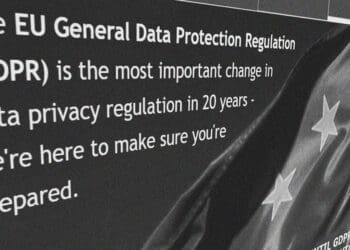Continually evolving data privacy legislation has put three approaching storm fronts on a collision course. Sandy Erez stresses that corporations should chart the unknown terrain to avoid ending up in the public eye of that potential “perfect storm.”
A Legislative Storm is Brewing: Take Shelter Under Your Data Privacy Umbrella Before It Hits
The consumer is king, and we are all subjects – data subjects, that is! But for corporations caught with their data breeches down, the treatment is anything but royal. As one big fish one after another (Marriott, British Airways, Equifax, etc.) is called out for exposing their consumers’ privacy parts, everyone else is scrambling to make sure they don’t become the next breached whale to wash up on the rocky shores, coughing up huge sums of money.
Early Storm Warnings in the EU: Isn’t Everyone Ready?
The General Data Protection Regulation (GDPR) was adopted in April 2016 with the expectation and requirement that it be fully implementable in the EU countries by May 2018. But did that happen?
The truth is, although GDPR splashed onto the EU scene, making huge waves in data protection awareness, it only had a ripple effect when it comes to responsiveness and readiness in meeting the practical side of this compliance challenge.
According to a McDermott and Ponemon Institute survey, despite making investments to bring on data protection personnel and implementing new business practices, only 18 percent of companies surveyed were highly confident in their ability to communicate a reportable breach within 72 hours – and that is just the EU!
It seems the soft underbelly of the GDPR beast is the the reporting requirement that remains difficult to get right. Apparently, neither over-reporting nor under-reporting to regulators is a good thing, and mandatory reporting to data subjects might just lead to increased class-action litigation. It appears that the foggy atmosphere is forcing people to tread cautiously to avoid unforeseen financial and reputational sinkholes.
Reading the “Whether” Maps in The United States
On the other side of the world, in hot pursuit of similar legislation, the United States is also watching the “whether” – meaning whether or not pending bills will pass. Not willing to wait for a federal law to be drafted and passed to fit one and all (a seemingly impossible feat), states are bypassing the government dingy and ferociously pushing their own data privacy agendas ahead.
Presently, around 25 states have privacy laws (dealing with government and private entities or both) – with hundreds more bills brewing in the clouds of Congress. Only when the legislation rains down will their fate be decided – so when and if these bills are passed, U.S. companies will need to navigate through city, state and potentially federal laws for their legal obligations with regard to notices, transparency, information security, data subject rights and more.
At the same time, their own terrain is rife with legislative landmines that could momentarily explode. U.S. companies will need to hold on to their hats, because the gales of GDPR are also at their back! Two storm fronts are colliding… which brings me to the next and third key storm front: ecosystems.
Global Forecast: Cloudy with a Strong Chance of Uncertainty
No good meteorologist will prepare their local forecast without first examining global activity, and that goes for data privacy storm chasers as well. Most companies in our global, data-centric economies now operate as “extended enterprises” in that their data tributaries are criss-crossing any number of local, national and international borders. Uncertainty as to how the pieces fit together, along with the continuing uptick in regulations, will precipitate difficulties in being able to work with clients, suppliers and contractors, each in their own data regimes.
This is no tempest in a teapot – just stir China’s Cybersecurity Law with a sprinkling of the California Consumer Privacy Act and serve it to the GDPR-brewed U.K. … and you get the picture. You don’t want to wade through that legislative swamp without a guide. And it’s only going to get more complicated.
Minimize the Damage as You Would for Any Storm: Batten Down the Hacks and Prepare
Now that the covert uses of corporate data have been sprung from lock and key, boards and management are quaking in their boots, (or galoshes and wellies, depending on their location), knowing there is no way to stem the tide of oncoming legislation. The following are some protective measures to minimize the risk:
- Board up Your Data Privacy Windows – Board members need to have a direct window into the risk elements pertinent to extended enterprise operations, including knowledge of the level of controls at third- and fourth-party entities. Moreover, now that risk comes with personal liability (lawsuits have been filed against directors and other individuals), board members and management must be trained properly on the topic, as well as being privy to clear, understandable reporting on the situation.
- Use Ethics as Your Guiding Light –There is no doubt it will be difficult to maneuver through hundreds of U.S. and global data privacy laws. One way to cut through the fog might be to to shift the company’s sights from being compliance-driven to ethics-driven. Doing right by the customer should fit with any legislation, whether it be baseline or comprehensive (prescriptive), rights-based, risk- and harms-based and/or accountability-based. Anchoring business practices in ethics and brand values will ensure internal and external human interests are equally balanced.
- Double-Check Your Technology – If you are developing products, remember that privacy by design will over time become synonymous with product excellence. That means including considerations for owning the data life cycle and documenting the associated risks. If you are procuring technologies – bots, for example – make sure you have a clear understanding of the data risk profile before implementation.
- Collaborate and Data Map – In order for decision-makers to understand the full consequences of both utilizing and not utilizing data, it is critical that all relevant stakeholders and departments (legal, security, senior management, IT, business, etc.) share, assess, consult and collaborate between themselves. This also includes knowing where company data lives, how it flows, what you are doing with it and why you have it.
Storm Warnings are Elevated and in Effect: Take Action
The word is out: Consumers, no longer blindly loyal to their brands, have taken up the cause of data privacy, and it is their advocacy that is driving the laws and regulatory changes. If the news is any indication, corporations dragging their feet in comprehending the severity of not knowing their way around the data privacy landscape will continue paying for it heavily.
You want to be safe? Get familiar with your data vehicle (it might be your lifeboat!) and always expect the unexpected legislation to fall from the sky.
And keep your breeches buttoned tight.














